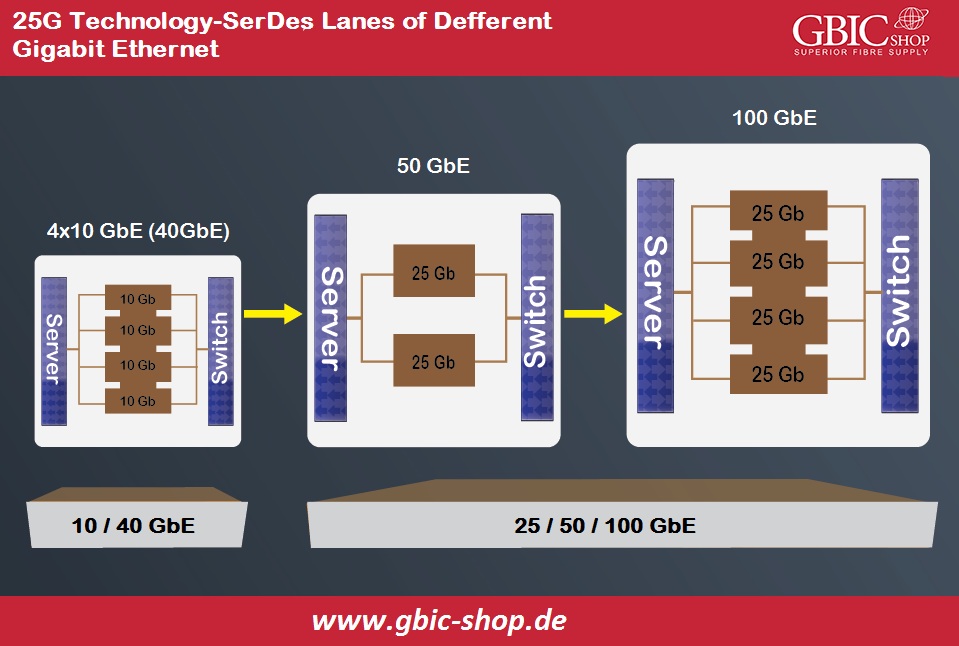10 Gigabit and 40 Gigabit technologies have developed and captured a considerable market in the last ten years. In current years, 25 Gigabit/50 Gigabit/100 Gigabit technologies are getting more approach and start to stick out in upcoming network implementations. We have not directly designed these growing Ethernet technologies to adjust a new high-level speed but to satisfy specific market requirements and developments. This article will introduce some essential25 Gigabit/50 Gigabit/100 Gigabit technologies to understand the thought behind.
The Technology of 25G:
Aiming at cloud computing data centers, the official approval of 25 Gigabit standards took place in 2016, many years later compared to 10G/40G/100G standards. Moreover, the maximum benefit of 25 Gigabit rests in the technology of SerDes, which we use in excessive speed communications for changing serial data into parallel interfaces, decreasing the numbering of interconnects and I/O pins.

Many switches work SerDes and a standard clock of about ten gigahertz, favoring a 10 Gigabyte transfer rate. Currently, the technology of SerDes has enhanced to 25 gigahertz. This enhancement causes differences in productivity and expenses of 10G, 40G, and 25G implementation. Leveraging 25 gigahertz SerDes lane, 25 Gigabit favors just one way at 25 Gigabytes per second, which is bandwidth functioning of 10 Gigabit for two and a half times utilizing a ten gigahertz lane. While developing from 10 Gigabit to 25 Gigabit, we can avoid rewiring as 25 Gigabit switches use Small Form Factor Pluggable 28 optical transceivers adaptable to LC fiber optics 10 Gigabit. Furthermore, 25 Gigabit can provide four times the port density of 40 Gigabit switches which needs 4 10 gigahertz lanes. So, the migration way 10G, 40G, and 100G are undoubtedly expensive whereas less effective and scalable.
.jpg)
The Technology of 50G:
25 Gigabit stimulates the expectation of high-level communication rates in the market. So, the launch of 50 Gigabit standards took place in 2018, having a similar architecture like 400G and 200G standards working as the upcoming high-speed determination for connecting data centers and servers. 50 Gigabit implementations can reutilize the 25 Gigabit devices within the current 100 Gigabit network to decrease the price. Thus, the cost of 50 Gigabit can be fifty percent of 40 Gigabit; nevertheless, the functioning can boost by 25%. Whereas the most powerful technology for attaining the excellent performance of 50 Gigabit is PAM4.
.jpg)
50 Gigabit gets to 53.125 Gigabit per second after encoding FEC, which we cannot transmit above an electric interface while maintaining the signal's integrity. So, we adopt PAM4 to map pair of bits in just one symbol, creating a general brand rate like 26. 5625 Giga Baud in the interest of 50 Gigabit per second per lane. We widely use PAM4 in excessive speed signal linkage, providing higher transmission effectiveness at a low price than former NRZ. PAM4 at 50 Giga Baud offers a way to 100 Gigabit through a 1*2*50* Giga Baud structure that needs just one laser but attains improvement in communication rate from 10 Gigabit to 100 Gigabit.
.jpg)
The Technology of 100G:
Satisfying the requirements of excessive speed and extensive transmission, the approval of the first 100 Gigabit standards took place in 2010. Furthermore, we observed tremendous changes in the coming years. It looks as 100 Gigabit is slowly dominating 40 Gigabit within data centers because of good performance follow-up, industrial chain progress, technical solution integration, and the benefit of a higher communication rate. And more extended range, which we attribute to the technology of DWDM it utilizes.
.jpg)
100 Gigabit DWDM technology provides high-level capacity transmission above one wavelength over extensive ranges, and we mainly use it for high-level speed fiber optic communications. Coherent CFP, CFP2, and CFP4 DWDM fiber optic transceivers are there for 100 Gigabit DCI or MAN feasible to 80 Kilometers; otherwise, long-haul connection greater than 1000 kilometers, transporting different 10G, 40G, and 100G services to cater to the growing demands for excessive bandwidths. Moreover, utilizing 100 Gigabit DWDM mux-ponder/transponder can evade the remake of network structure as attaining transport capacity and smooth conversion among 10G, 40G, and 100G because it multiplexes multi-rate and multiprotocol services.
.jpg)
The Connection among 25G, 50G, and 100G:
25G, 50G, and 100G all possess wide implementations in cloud computing data centers these days, and combining them can attain the 10G, 25G, 50G, and 100Gnetwork upgrade. Before developing 25 Gigabit and 50 Gigabit, the popular migration way is 10G, 40G, and 100G, which is very expensive but ineffective. However, development from 25 Gigabit to 100 Gigabit is a low-priced solution. Based on 25 Gigabit, we can achieve this migration by 2x50 Gigabit or 4x25 Gigabit Serializer/Deserializer lanes leveraging the latest spine and leaf architectures. Overall, the 25G, 50G, and 100G migration paths offer a lower price for each bandwidth's unit by entirely using switch port capacities and setting the base for more development to 200 Gigabit and 400 Gigabit. It provides excellent transmission efficiency and functioning, both OPEX and CAPEX savings via high backward adaptability and the current cabling infrastructure reusing.
.jpg)
Conclusion:
These emerging technologies of 25G, 50G, and 100G are appropriate for different industry requirements and lead the market's tendency in turn. We know well that 25G, 50G, and 100G each possess their benefits in performance and cost for adopting other advanced technologies instead of 10 Gigabit and 40 Gigabit. Whereas the requirements never stop, technology development will never cease advancing either. The network organizers expect a balance between technology reuse and speed to get a low-priced solution. We have to wait and observe what the future brings for us.
 English
English
 Deutsch
Deutsch
 Espaniol
Espaniol










